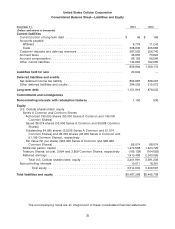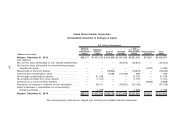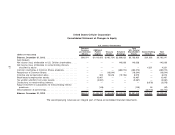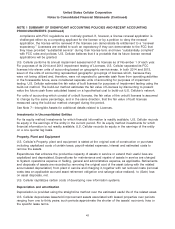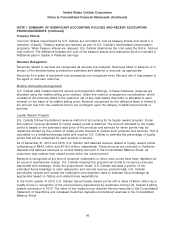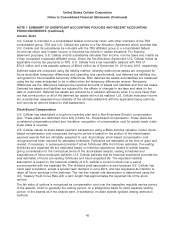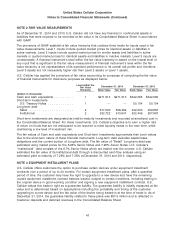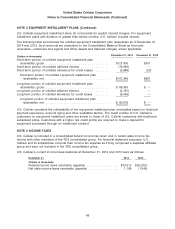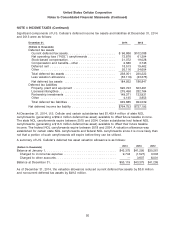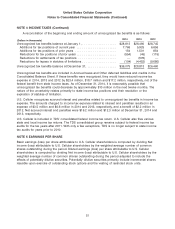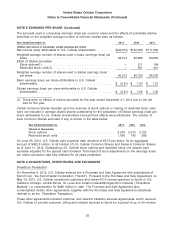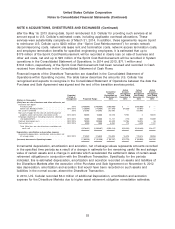US Cellular 2014 Annual Report Download - page 53
Download and view the complete annual report
Please find page 53 of the 2014 US Cellular annual report below. You can navigate through the pages in the report by either clicking on the pages listed below, or by using the keyword search tool below to find specific information within the annual report.United States Cellular Corporation
Notes to Consolidated Financial Statements (Continued)
NOTE 1 SUMMARY OF SIGNIFICANT ACCOUNTING POLICIES AND RECENT ACCOUNTING
PRONOUNCEMENTS (Continued)
Income Taxes
U.S. Cellular is included in a consolidated federal income tax return with other members of the TDS
consolidated group. TDS and U.S. Cellular are parties to a Tax Allocation Agreement which provides that
U.S. Cellular and its subsidiaries be included with the TDS affiliated group in a consolidated federal
income tax return and in state income or franchise tax returns in certain situations. For financial
statement purposes, U.S. Cellular and its subsidiaries calculate their income, income taxes and credits as
if they comprised a separate affiliated group. Under the Tax Allocation Agreement, U.S. Cellular remits its
applicable income tax payments to TDS. U.S. Cellular had a tax receivable balance with TDS of
$74.3 million and a tax payable balance of $34.8 million as of December 31, 2014 and 2013, respectively.
Deferred taxes are computed using the liability method, whereby deferred tax assets are recognized for
future deductible temporary differences and operating loss carryforwards, and deferred tax liabilities are
recognized for future taxable temporary differences. Both deferred tax assets and liabilities are measured
using the tax rates anticipated to be in effect when the temporary differences reverse. Temporary
differences are the differences between the reported amounts of assets and liabilities and their tax bases.
Deferred tax assets and liabilities are adjusted for the effects of changes in tax laws and rates on the
date of enactment. Deferred tax assets are reduced by a valuation allowance when it is more likely than
not that some portion or all of the deferred tax assets will not be realized. U.S. Cellular evaluates income
tax uncertainties, assesses the probability of the ultimate settlement with the applicable taxing authority
and records an amount based on that assessment.
Stock-Based Compensation
U.S. Cellular has established a long-term incentive plan and a Non-Employee Director compensation
plan. These plans are described more fully in Note 16—Stock-based Compensation. These plans are
considered compensatory plans and, therefore, recognition of compensation cost for grants made under
these plans is required.
U.S. Cellular values its share-based payment transactions using a Black-Scholes valuation model. Stock-
based compensation cost recognized during the period is based on the portion of the share-based
payment awards that are ultimately expected to vest. Accordingly, stock-based compensation cost
recognized has been reduced for estimated forfeitures. Forfeitures are estimated at the time of grant and
revised, if necessary, in subsequent periods if actual forfeitures differ from those estimates. Pre-vesting
forfeitures and expected life are estimated based on historical experience related to similar awards,
giving consideration to the contractual terms of the stock-based awards, vesting schedules and
expectations of future employee behavior. U.S. Cellular believes that its historical experience provides the
best estimates of future pre-vesting forfeitures and future expected life. The expected volatility
assumption is based on the historical volatility of U.S. Cellular’s common stock over a period
commensurate with the expected life. The dividend yield assumption is zero because U.S. Cellular has
never paid a dividend, except a special cash dividend in June 2013, and has expressed its intention to
retain all future earnings in the business. The risk-free interest rate assumption is determined using the
U.S. Treasury Yield Curve Rate with a term length that approximates the expected life of the stock
options.
The fair value of options is recognized as compensation cost over the respective requisite service period
of the awards, which is generally the vesting period, on a straight-line basis for each separate vesting
portion of the awards as if the awards were, in-substance, multiple awards (graded vesting attribution
method).
45


